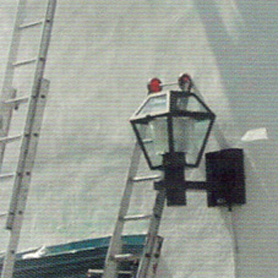Lime Paints from St Astier
USER RECOMMENDATIONS
Vibrant and beautiful, the St Astier lime paint range is the perfect compliment to lime plaster and render, being suitable for most backgrounds. Can be applied to gypsum plasters, lining paper, cement, lime plaster and render, bricks, blocks and untreated timber.
Mixing
The general ratio is 1 volume of powder to 2 volumes of clean water. Further dilution may be necessary on porous backgrounds.
The lime paint is supplied in tubs as a powder for mixing on site with water. The tub has a fill line for normal use.
Proper mixing is essential. When mixed it should be completely free of lumps or fine particles. Check the bottom and sides of the mixing tub to ensure all the powder is fully combined.
Application
- Do not work in temperatures below 8°C or above 30°C or in a humid environment.
- Protect painted areas from direct sun, drying wind and rain for 3 to 4 days (longer in damp weather conditions).
- Do not use warm air dryers.
- All new rendered or plastered surfaces should be properly dry before applying lime paints.
- Apply with a good quality long hair brush in short strokes.
- Evenly and thinly spread the lime paint on the surface, work into any small hollows or cracks.
- Do not overload the brush, use only the bottom third of the bristles, do not apply unevenly.
- Stir regularly during application.
- Generally 2 coats are sufficient.
- Wait 12-24 hours between coats.
- On large areas of work, always keep the working edge damp, do not allow the lime paint to dry out and form a dry joint.
- Maintain a dampened background in advance of application with a light mist spray if necessary.
- Sufficient personnel should be used to complete large areas without forming dry joints.
- Always finish whole walls or elevations into details, angles, corners, down pipes or the like in one operation to avoid colour banding.
- St. Astier Lime Paints can be sprayed: please consult The Traditional Lime Company.
Background
- Remove any loose or flaking paints and repair defective plasters or renders.
- Test the background for suction by lightly flicking clean water from a brush on to the surface of the wall.
- Rapid suction into the background means that dampening with clean water will be required. In this case it may also be necessary to thin the first coat with 30% additional water. If thinning is required mix as normal then take out with a measured container the quantity you require to be thinned, place it in a separate container and add the extra water.
- A low suction background does not require pre wetting or additional thinning for the first coat.
- Very smooth or polished surfaces offering little or no suction might require sanding down with sand paper to create the necessary suction.
- Ensure that background is dry, clean and sound.
- Do not use lime paint in areas subjected to abnormal condensation such as a kitchen or bathrooms, unless sufficient ventilation is available to prevent condensation.
- Lime paints are not film-forming materials that will hide the background condition therefore salts and dampness will show through.
- Some surfaces may have variations in background materials (i.e. brick, stone, cement, etc) and therefore care is required in controlling differing suction levels.
- Due to the additives content of some modern gypsum premixed plaster there may be some reaction with lime paints. Furthermore gypsum plasters tend to be extremely smooth and therefore would need to be lightly sanded down to provide a suitable surface before applying lime.


